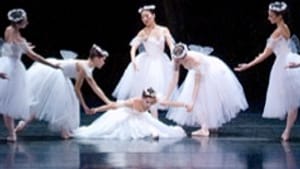Stay in the Loop
BSR publishes on a weekly schedule, with an email newsletter every Wednesday and Thursday morning. There’s no paywall, and subscribing is always free.
And the moral of the story is....
Pennsylvania Ballet's "Sylphide' and "Barber Violin Concerto' (

The Pennsylvania Ballet looked to close its 45th anniversary season with a much-hyped restaging of Bournonville's La Sylphide, last performed by the company 21 years ago. But Sylphide's lackluster staging floundered in comparison to the brilliantly executed company premiere of Peter Martins's Barber Violin Concerto.
Staged properly, the ill-fated love story of La Sylphide should achieve the status of a moral lesson elevated to the level of mythic tragedy. On the day of his wedding, a Scottish farmer James (Zachary Hench) is lolled out of his slumber and enchanted by a Sylph (the enchanting Julie Diana). He initially believes she's part of a dream; but when his fiancée Effy (Abigail Mentzer) awakens him with a kiss, he's visibly annoyed at being disturbed.
James thinks he sees the Sylph reappear, but a witch (Francis Veyette as Madge) replaces her. The young Scot wants to cast the haggard creature out, but Effy shows pity and intervenes. In turn, Madge tells the fortunes of all the guests and predicts that Effy will suffer heartbreak by James and instead marry Gurn (Ian Hussey), her long spurned other suitor. When the Sylph returns—framed by John Hoey's lighting into a vision of love's promise— James damns his earthly bride by choosing an ideal one that he literally follows out the window.
In Peter Cazalet's towering set, a stag-head mounted chandelier hangs from the ceiling as an object of grotesque beauty. The production infuses some slick effects; Diana "magically" rides down a panel in the wall and later vanishes through the false back of a chair. Visually brilliant ensemble segments in Act I show a Scottish take on classical ballet, and Hussey dances his jump filled solo with an ease only bested by Hench's admirable skill.
Standing a moral on its head
Unfortunately, the ballet's staging paid insufficient attention to Sylphide's still relevant moral: Be careful what you take for granted. In this production, a dearth of fairy-tale feeling and the lack of any pathos turns the story on its head, completely muting the tragic impact—especially in the final scene, where some folks in the audience laughed at Veyette's cartoonish portrayal of evil.
Rather than appear as the noble romantic, Hussey's cowardly backstabbing irritated me in every scene, so that Effy effectively became the real tragic victim (forced to settle for a suitor she had formerly condemned to the friend-zone).
Instead of conveying a message of woe for James, the moral instead reads like lines from Browning: "A man's reach should exceed his grasp; else what's a heaven for?" In this interpretation, James dances among the Sylphs (exquisitely portrayed by the corps) and gets a glimpse into another world. It ruins him forever, but so what? For one day he chased after and knew something that most will never even dare to reach for.
Legs swimming across stage
The four dancers (Riolama Lorenzo, James Ihde, Laura Bowman, and Maximilien Baud) who performed Peter Martins's Barber Violin Concerto showed no such defects in conveying the intertwining love stories of his piece. Through the delicate first movement of Samuel Barber's music, Martins's choreography emphasizes the clean, long lines of their bodies; clothed all in white by William Ivey Long, they evoke a dream-like sense of purity.
Both barefooted, Baud holds Bowman horizontally across his body, her legs swimming across the stage as he carries her. Lorenzo's flawless pointe work sweeps her across the floor as Ihde watches, and the two couples' interlocking stories— one of grace and elegance, the other a fire of young passion— express in movement emotions of ardor and longing.
Sorrow made visible
As in Sylphide, nothing ends happily in Barber, and in the next two movements, the partners switch. Lorenzo enters alone, searching the stage, later joined by Baud on a similar quest for lost love. Together, their pas de deux expresses loneliness (something I would have thought unfathomable in a duet). His body bends like sorrow made visible, and when he grasps her waist, she collapses in agony that's horrible to watch.
But longing yields to a hunger— in this case a gorgeous lift when Lorenzo finally succumbs— tinged by betrayal and the pain of guilt. And while Ihde's stoic wandering tries to resist similar advances by Bowman in the third movement, her impressive coquettish charm first annoys and then endears him with quick, flirty steps. Bowman's smile and attitude brighten the entire finish (her much shorter stature makes it a perfect role for her), and though they're incompatible lovers, this wonderful, short work by Martins shows that in love, even oil and water can learn to mix together. â—†
For another review of La Sylphide by Janet Anderson, click here.
Staged properly, the ill-fated love story of La Sylphide should achieve the status of a moral lesson elevated to the level of mythic tragedy. On the day of his wedding, a Scottish farmer James (Zachary Hench) is lolled out of his slumber and enchanted by a Sylph (the enchanting Julie Diana). He initially believes she's part of a dream; but when his fiancée Effy (Abigail Mentzer) awakens him with a kiss, he's visibly annoyed at being disturbed.
James thinks he sees the Sylph reappear, but a witch (Francis Veyette as Madge) replaces her. The young Scot wants to cast the haggard creature out, but Effy shows pity and intervenes. In turn, Madge tells the fortunes of all the guests and predicts that Effy will suffer heartbreak by James and instead marry Gurn (Ian Hussey), her long spurned other suitor. When the Sylph returns—framed by John Hoey's lighting into a vision of love's promise— James damns his earthly bride by choosing an ideal one that he literally follows out the window.
In Peter Cazalet's towering set, a stag-head mounted chandelier hangs from the ceiling as an object of grotesque beauty. The production infuses some slick effects; Diana "magically" rides down a panel in the wall and later vanishes through the false back of a chair. Visually brilliant ensemble segments in Act I show a Scottish take on classical ballet, and Hussey dances his jump filled solo with an ease only bested by Hench's admirable skill.
Standing a moral on its head
Unfortunately, the ballet's staging paid insufficient attention to Sylphide's still relevant moral: Be careful what you take for granted. In this production, a dearth of fairy-tale feeling and the lack of any pathos turns the story on its head, completely muting the tragic impact—especially in the final scene, where some folks in the audience laughed at Veyette's cartoonish portrayal of evil.
Rather than appear as the noble romantic, Hussey's cowardly backstabbing irritated me in every scene, so that Effy effectively became the real tragic victim (forced to settle for a suitor she had formerly condemned to the friend-zone).
Instead of conveying a message of woe for James, the moral instead reads like lines from Browning: "A man's reach should exceed his grasp; else what's a heaven for?" In this interpretation, James dances among the Sylphs (exquisitely portrayed by the corps) and gets a glimpse into another world. It ruins him forever, but so what? For one day he chased after and knew something that most will never even dare to reach for.
Legs swimming across stage
The four dancers (Riolama Lorenzo, James Ihde, Laura Bowman, and Maximilien Baud) who performed Peter Martins's Barber Violin Concerto showed no such defects in conveying the intertwining love stories of his piece. Through the delicate first movement of Samuel Barber's music, Martins's choreography emphasizes the clean, long lines of their bodies; clothed all in white by William Ivey Long, they evoke a dream-like sense of purity.
Both barefooted, Baud holds Bowman horizontally across his body, her legs swimming across the stage as he carries her. Lorenzo's flawless pointe work sweeps her across the floor as Ihde watches, and the two couples' interlocking stories— one of grace and elegance, the other a fire of young passion— express in movement emotions of ardor and longing.
Sorrow made visible
As in Sylphide, nothing ends happily in Barber, and in the next two movements, the partners switch. Lorenzo enters alone, searching the stage, later joined by Baud on a similar quest for lost love. Together, their pas de deux expresses loneliness (something I would have thought unfathomable in a duet). His body bends like sorrow made visible, and when he grasps her waist, she collapses in agony that's horrible to watch.
But longing yields to a hunger— in this case a gorgeous lift when Lorenzo finally succumbs— tinged by betrayal and the pain of guilt. And while Ihde's stoic wandering tries to resist similar advances by Bowman in the third movement, her impressive coquettish charm first annoys and then endears him with quick, flirty steps. Bowman's smile and attitude brighten the entire finish (her much shorter stature makes it a perfect role for her), and though they're incompatible lovers, this wonderful, short work by Martins shows that in love, even oil and water can learn to mix together. â—†
For another review of La Sylphide by Janet Anderson, click here.
What, When, Where
Pennsylvania Ballet: Auguste Bournonville’s La Sylphide; Peter Martins’s Barber Violin Concerto. Through June 13, 2009 at Academy of Music, Broad and Locust Sts. (215) 551-7000 or www.paballet.org.
Sign up for our newsletter
All of the week's new articles, all in one place. Sign up for the free weekly BSR newsletters, and don't miss a conversation.

 Jim Rutter
Jim Rutter